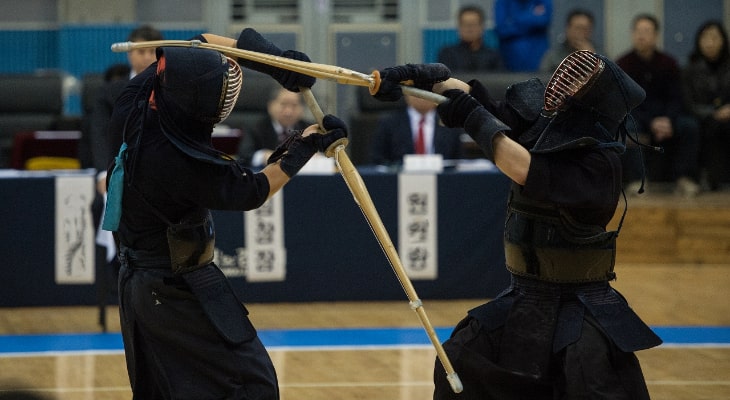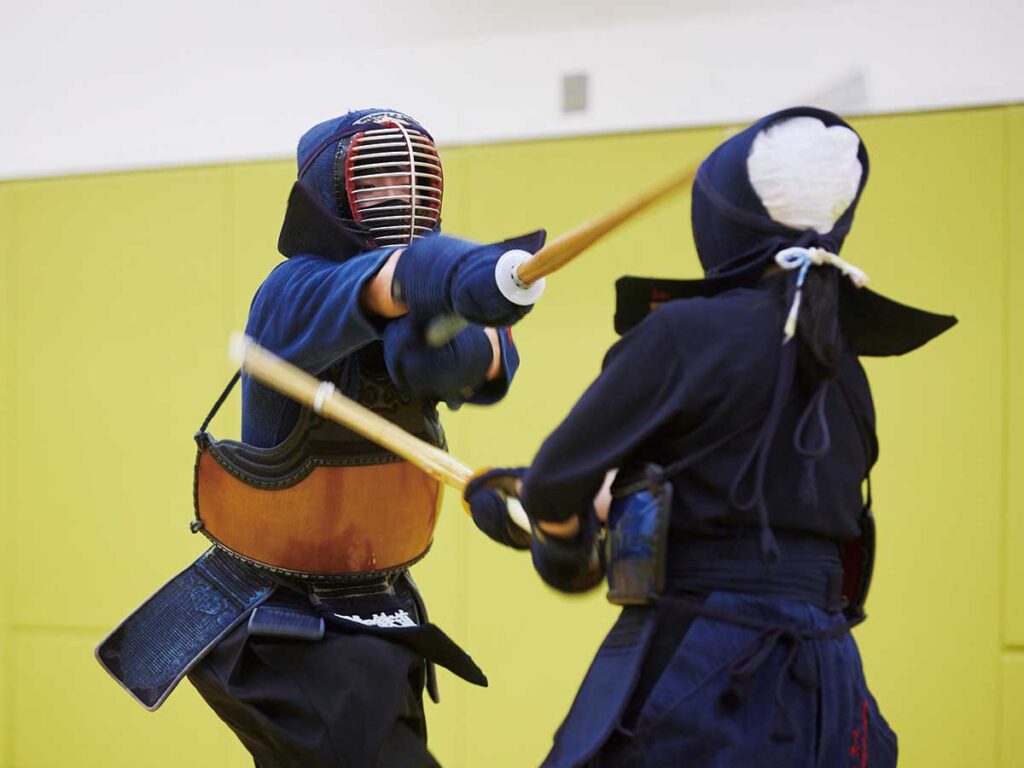
Kendo team competitions are a place where not only individual skill but also team strategy is tested.
In this article, we will explain in detail the order of each role in Kendo team competitions, from the vanguard to the general, and the strength of each.
The spearhead sets the flow of the game, the second in charge accelerates the flow, the midfielder reaches a turning point in the game, the vice captain maintains the flow, and the general ultimately decides victory – such tactical movements. And psychological warfare holds the key to team warfare.
Use this guide to understand the importance and tactics of each role and gain the insight you need to succeed in team competitions.
目次
- 1 What are the basics of Kendo team competitions?
- 2 The role of a spearhead and the strength required
- 3 Tactics and role of the next leader
- 4 Importance and technology of mid-career
- 5 Vice Admiral’s tactics and strength
- 6 The role and overwhelming strength of the general
- 7 Summary: Understanding tactics and individual roles in Kendo team competitions
What are the basics of Kendo team competitions?
Kendo team competitions are held in a format where each team competes in groups of five.
In this competition format, each player participates in the match in order from the vanguard to the general, and plays against players in the same order from the opposing team.
Team competitions differ from individual competitions in that the strategy and cooperation of the entire team determines the outcome.
Summary of rules for team competitions
The basic rules for Kendo team competitions are that each athlete competes one on one, and matches are usually best-of-three matches.
The match time is about 3 minutes per player, and the player who gets the most effective strikes during that time wins.
In case of a draw, the match may go to extra time.
In team competitions, the number of wins for each player is directly linked to the team’s victory, and in the case of a tie, the winner may be decided by the total score or the winner in the final match.
Importance and strategic meaning of each role
The role of each player in a team match is tactically very important.
The spearhead plays the role of setting the flow of the game and gives momentum to the team by winning.
The next leader fights to maintain that trend and further extend his lead or turn the tide against him.
The center field is the center of the game and serves as the turning point, so stable strength is required.
The vice captain and captain serve as the pillars of the team and play an important role in determining the final victory or defeat.
These players must have both mental strength and high technique, and the general position in particular is the one that is under the most pressure as everything will be decided in the final match.

The role of a spearhead and the strength required
As the first player in a team match, the Spearhead is responsible for setting the tone for the team.
Players in this position have their first direct confrontation with the opposing team at the beginning of the match and are required to win to create momentum for their team.
For this reason, it is extremely important for the spearhead not only to have high technical ability but also to have psychological strength.
When the spearhead wins, it boosts the morale of the entire team and has the effect of giving confidence to the following players.
Skills and mindset required as a vanguard
Skills required for a spearhead include quick thinking and tactical flexibility.
As soon as the match begins, you need to assess your opponent’s techniques and tactics and take appropriate responses.
For this reason, the vanguard is required to have the ability to fight using a variety of techniques, as well as to remain mentally calm.
It is important to have a strong will to overcome pressure and a strong sense of responsibility towards the team.
Spearhead tactics and their influence on the game
Spearhead tactics require a careful balance between being proactive.
In order to create flow in the match, you need to be aggressive but not put yourself in danger with forced attacks.
Also, the key is how the spearhead can block the opponent’s movements and advance the match according to his own rhythm.
The good performance of the spearhead in a match determines the team’s momentum, so its impact goes beyond just that one game and has a major impact on the team’s overall strategy.

Tactics and role of the next leader

Importance and technology of mid-career
The midfield position is the center of the game and the turning point in team matches.
This position requires high skill and mental strength, and plays an important role in steering or reversing the flow of the team.
Midfield players need to be technically balanced and have the versatility to deal with any opponent.
In addition, mid-level players are required to have the judgment to understand the flow of matches so far and choose tactics accordingly.
Tactics and psychological warfare in mid-career positions
Midfield players must be very flexible tactically.
If the flow of the match is in your favor, you need to further advance that advantage, and if it is against you, you need to fight to create an opportunity for a comeback.
The role of midfielders is also important in psychological warfare, and they are expected to apply pressure that lowers the morale of the opposing team.
These matches are often a psychological turning point for both teams, and mid-ranked players will need to approach the match with a calm and calculated strategy.
The significance of mid-level players as a turning point in team competitions
The midfield battle is a central turning point that determines the overall flow of the team battle.
A win for the midfielder can give the team a huge boost toward victory, while a loss can affect the morale of the entire team.
Therefore, the midfield position is considered to be one of the most important points for the team, both tactically and psychologically, and players who play this role are required to have extremely high skill and psychological strength.
How the midfielders control the flow of the game and guide the team in a direction that is advantageous will greatly determine the outcome of the team match.

Vice Admiral’s tactics and strength
The vice captain is positioned at the end of the team match and plays an extremely important role in determining the outcome of the match.
This position requires high technical and mental fortitude and is responsible for keeping the team flowing or scoring key points for a turnaround.
Vice-captains often compete in situations where the pressure of the match is highest, and their tactics and strength often determine the fate of their team.
Tactical importance as adjutant general
The tactical importance of a lieutenant lies in his ability to read the flow of the game and launch effective attacks at the right time.
Players in this position are required to understand the overall flow of the game and choose offensive or defensive tactics as needed.
The vice-captain’s tactics are an important phase before effectively determining the outcome of the match, so precise technique and strategic judgment are essential.
The burden on the admiral will vary greatly depending on whether the adjutant general further strengthens the advantageous situation or creates an opportunity for a reversal.
Skills and mental strength required of a lieutenant commander
Vice-captains are required not only to have advanced kendo techniques, but also to remain calm under intense pressure and be mentally strong.
Since there is a high possibility that the tide will change midway through the match, the vice-captain must always prepare for the worst-case scenario and calmly devise strategies to achieve the best outcome.
Additionally, a vice captain is often required to provide leadership that inspires teammates and increases their confidence in victory.
For this reason, a lieutenant must have both technical perfection and high mental fortitude.

The role and overwhelming strength of the general
The general is the last player to appear in a Kendo team competition, and serves as the team’s final line of defense.
This position is the face of the team and requires overwhelming strength and leadership.
Taisho matches are often important stages where the outcome of the match is at stake, so mental toughness is essential as well as technical perfection.
Attitude and techniques as a general
To fight as a general, you need not only a high level of kendo technique, but also calm and decisive judgment.
The general not only decides the team’s victory, but also sometimes takes on the responsibility of overturning an unfavorable situation.
For this reason, you need to be prepared to remain unfazed under any circumstances.
Additionally, technically speaking, players are required to have the ability to accurately exploit the opponent’s weaknesses while skillfully balancing attack and defense.
It is important for a general to assess the opponent’s technique and psychological state and choose the most effective strategy for the team.
The role played by the general in the final phase of a team match
The role played by the general in the final phase of a team match is more than just a technical battle; it is a role that boosts team morale and brings the game to a close.
Especially when the game is close, the battle of the generals is the last chance to decide the outcome for the entire team.
Under this pressure, the general must perform consistently and meet the expectations of his teammates and supporters.
This role can be said to be the most important and symbolic position in Kendo team competitions, as the victory or loss of the general directly determines the team’s results.

Summary: Understanding tactics and individual roles in Kendo team competitions
In Kendo team competitions, it is extremely important to understand the role each player plays and apply tactics based on that.
Team competitions require not only a high level of individual skill, but also a sense of unity and strategic movement as a team.
This chapter explained the tactical importance of each role and a holistic approach to team success.
Comprehensive strategy for team competition success
Success in Kendo team competitions depends not only on the technical improvement of individual athletes, but also on their tactical considerations and psychological preparation.
In order to develop effective tactics, it is necessary to take advantage of each player’s strengths and cover their weaknesses.
When formulating a strategy for the team as a whole, it is essential to analyze the opposing team’s tactics and take optimal countermeasures.
Additionally, psychological support tailored to each player’s position is essential to winning team competitions.
Approach to strengthening and growing players in each position
It is important to support the growth of players in each position through regular technical practice and deepening their tactical understanding.
By setting up training programs specific to each role, from the spearhead to the general, and practicing with a tactical intent, players can grow into more tactically sensitive kendo players.
Additionally, through regular evaluation and feedback, we can monitor each player’s progress and adjust training methods as needed, which will strengthen us as a team.
In this way, maximizing the potential of each player is an essential element for the success of team competitions.



